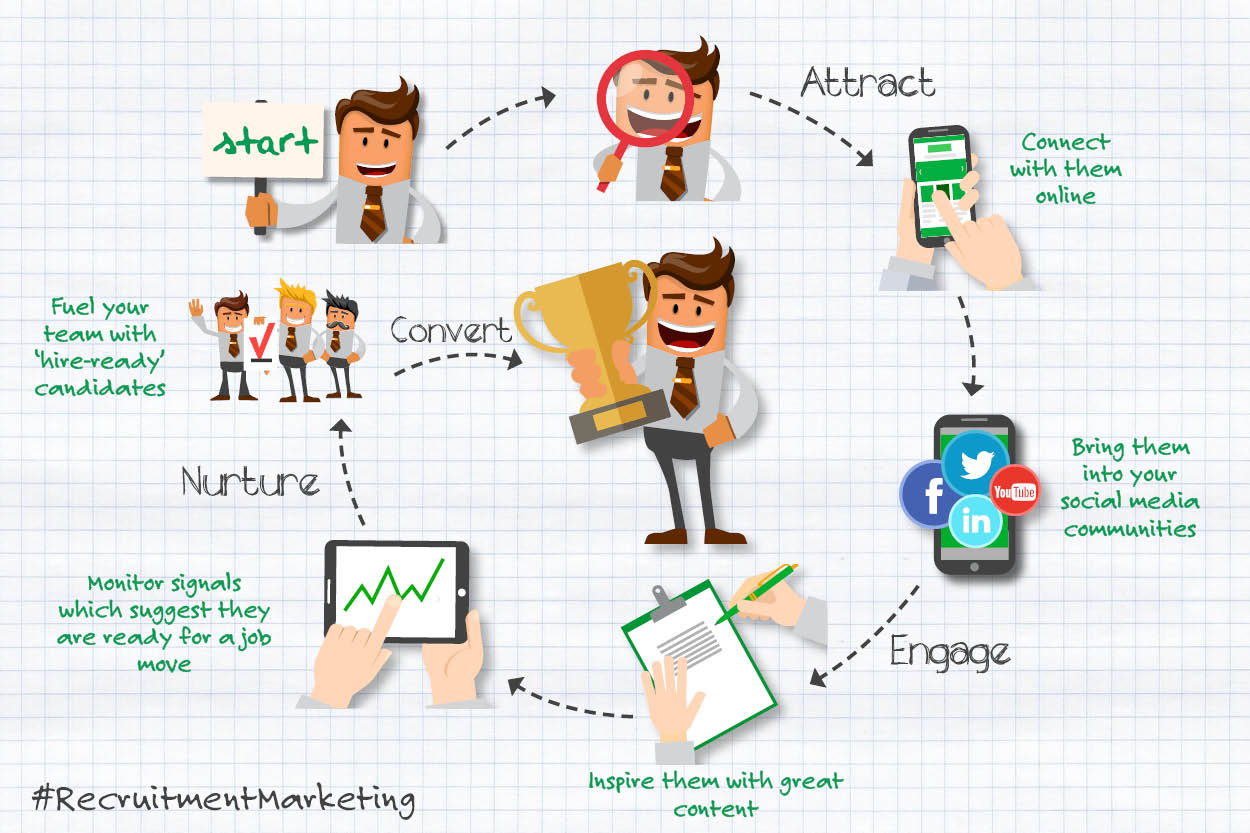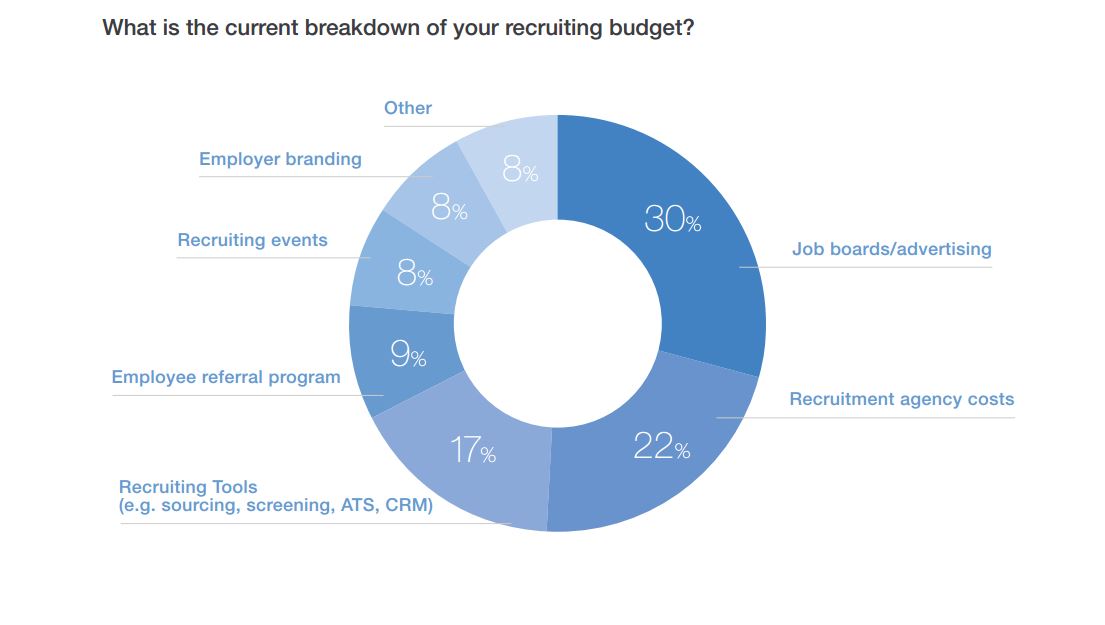1. Employer branding remains top priority
Which company do you want to work for? Google with well-known amazing corporate culture, high compensation, appealing peaks and diversified workforce or an unknown company name? The winner must be Google! The company doesn't gain this attraction by chance for sure. The popularity of Google in the eyes of candidates is thanks to its global widely known corporate brand and employer brand. You might know that Google is the No. 1 place to work for (2016) the seventh time in 10 years ranked by Fortune.
Employer branding is vital for not only technology companies like Google but all businesses in the world, no matter what sector they are operating. Many researches and real-life example have proved the crucial role of employer brand in attracting, engaging and retaining talented candidates and employees.

There remains a noticeable paradox in employer branding strategies of companies around the global. In spite of the fact that 80% HR leaders value the importance of employer branding in hiring talent, only 8% of their recruiting budget is invested in this key element. Its hard-to-measure return on investment makes HR leaders hesitate to pour a large portion of their fixed budget into employer branding. However, the good news is they believe in a better perspective with 53% of them would invest in employer branding if having unlimited budget as a long-term strategy.
To build a strong employer brand, you need to define your company culture first. Company core values will be translated into activities including recruiting practices to hire the best culture fitting candidates for your organization. Organizational mission will be the differentiator in the near future followed by core values.
2. Employee referrals need more investment
Although employee referrals remain the top source of quality hire rated by recruiters, companies allocate only 9 percent of their recruiting budgets for employee referral programs. Most recruiting expenses lie on such traditional channels as job boards (30%) and staffing agencies (22%).
Results from all studies indicate that you can save a lot of money and time to hire when working with referral candidates. Referred employees usually have better performance, longer tenure and better culture fit than other sources of hire.
However, to get referrals from your current staff is not easy at all. You need an engaged workforce to succeed in employee referral program in the long run instead of proving monetary incentives only. Values-based recognition programs need to be paid more attention to keep your employees engaged.
3. Recruiting automation is on the rise
There's no denying that big data is the future of recruiting. In the era of technology, data, algorithms and analytics facing recruiters everywhere on the way they look for new hires. Thanks to the availability of information on the Internet and the development of applicant tracking systems, today's recruiters can enjoy the fruits of big data in recruiting process.

Data-driven recruiting helps recruiters save a lot of time and effort in reaching, screening and sourcing candidates. Moreover, algorithms and analytics can bring the best fitting candidates with a broader range of criteria (for instance: skills set, leadership qualities, personality assessment). Automation will minimize human bias in screening and sourcing candidates with objective selections.
Despite the power of big data, it couldn't replace human factor in the recruitment process. Data can't automatically produce output (choices of suitable candidates) alone. In the matrix of available information collected from social media platforms like LinkedIn, Facebook, Twitter; job boards databases and directly submitted resumes; recruiters are required to have additional logical and analytical skills. HR professionals need the ability to understand algorithm results and interpret them into human-friendly versions. As a recruiter, you also deeply involve in machine learning to make the algorithms more and more precise. And beyond all, recruiters still play an important role in connecting, communicating and engaging candidates to find the right placements. No machine can do that job as well as making a hiring decision instead of human recruiters and hiring managers.
4. Diversity hiring will continue to be a major focus worldwide
According to LinkedIn, 37 % HR leaders share the ideas that hiring for more diversity will shape the recruiting industry in the next few years. This trend has become recruiting strategies of a lot of large companies, including respected names in technology, energy, construction, hospitality, and so on around the global. They not only increase diversity in their workforce in their projects or branches but also head offices.

Entelo's 2017 Annual Recruiting Trends Report revealed that “67.4% of talent acquisition pros are reporting management either supports or strongly supports workplace diversity.” It is a big move to make the most of a diverse workforce. Companies and HR leaders have been putting more effort and investment into diversity-centric strategies as an essential part of their long-term strategic plans.
Different groups of employees bring fresh ideas to the table. Both the company and employees can benefit from the workforce diversity. Employees can learn from each other for mutual development (skills, cross-cultural awareness, etc) and receive good compensation while the company enjoys outstanding revenue that high productive diverse workforce brings. There has been a surge of anonymous hiring in many international companies as one of the best recruiting practices for diversity in recent years.
5. The talent war is becoming more and more severe
Businesses in all sectors have been experiencing a difficult time of global economic frustration due to low oil prices. You might remember that oil prices crashed to below $27 a barrel in the first quarter of 2016, the lowest level since 2003, then bounced back to around $50 a barrel in late November. However, the recruiting outlook for 2017 seems very promising in the hope of a better economic perspective across the global. 56% of recruiters said that their hiring volume will increase in 2017 while their team sizes and recruiting budget are likely to stay the same.
Sales, operations, engineering and IT occupations are in highest demand in the next year, according to both corporate recruiters and staffing professionals. 57% of recruiting teams find intense talent competition the top challenge they are confronting. Traditional hiring practices need to be improved to keep pace with the ever-changing digital world.

Whether you like it or not, candidates are talking behind your back. It's time for recruiters to walk a mile in candidates' shoes to know how they want to be recruited. Recruiters need to have a marketer mindset and consider candidates as your target customers. The good news is there are so many useful tools for modern recruiters in recruitment marketing approach, but the bad news is the best fitting candidates are becoming more and more difficult to find out and deal with.
The key tactic to attract the best talent is to make your company top in mind of both active and passive candidates as a great place to work for. You might want to note that candidate experience and employee experience can make or break your employer brand.
6. Recruitment marketing opens a new era of talent acquisition
The year 2016 has witnessed the deeper integration of HR and marketing in an attempt to win the more and more severe talent war. You might probably hear of recruitment marketing as an emerging approach to talent acquisition. Thanks to big data, sourcing tools, ATS, CRM and other automation tools for HR professionals and recruiters, recruitment marketing is not a hard-to-implement strategy anymore. The demographics of your candidate pools help recruiters easily segment candidates by groups, which will save a lot of time, effort and money in every specific vacancy. By understanding each group's needs, you can not only generate new potential hires but also nurture them to successful hires.

The job of marketing recruiters is not limited to contacting candidates whenever having suitable seats for them. Creating a talent network, staying in touch with them and providing them with what they really care will bring you an engaged talent pipeline. For instance, when you have only one seat but two excellent candidates, who will you choose? Of course, you can choose only one, but it's not the end with the remaining candidate. He or she can be the next successful hire in your company in the future, so be sure to keep him or her engaged with your company.
A real-life example of successful recruitment marketing approach is IKEA Australia 'Assembling your career' recruitment campaign. IKEA Australia smartly executed their creative talent acquisition strategy by concealing the job description inside every pack of furniture sold. Their customers often delivered the pack by themselves, and they were already this brand fans. When receiving interesting job opportunities, they were willing to share with their neighbors, relatives and friends. It's a simple but brilliant idea which helped them win 4,285 applications filled with 280 of those hired without a penny! It's an incredible hiring result that costly recruitment campaigns can only dream about. IKEA Australia achieved it by understanding their target market at the highest level.
*Source of data: LinkedIn's Global Recruiting Trends 2017
Which of these 6 recruiting trends are you interested in the most? We’d love to hear more thoughts and insight from you in the comment below!













Replies to This Discussion